Cite this document
(“Ontario's Recod on Electing Women Essay Example | Topics and Well Written Essays - 2500 words”, n.d.)
Ontario's Recod on Electing Women Essay Example | Topics and Well Written Essays - 2500 words. Retrieved from https://studentshare.org/miscellaneous/1503866-ontarios-recod-on-electing-women
Ontario's Recod on Electing Women Essay Example | Topics and Well Written Essays - 2500 words. Retrieved from https://studentshare.org/miscellaneous/1503866-ontarios-recod-on-electing-women
(Ontario'S Recod on Electing Women Essay Example | Topics and Well Written Essays - 2500 Words)
Ontario'S Recod on Electing Women Essay Example | Topics and Well Written Essays - 2500 Words. https://studentshare.org/miscellaneous/1503866-ontarios-recod-on-electing-women.
Ontario'S Recod on Electing Women Essay Example | Topics and Well Written Essays - 2500 Words. https://studentshare.org/miscellaneous/1503866-ontarios-recod-on-electing-women.
“Ontario'S Recod on Electing Women Essay Example | Topics and Well Written Essays - 2500 Words”, n.d. https://studentshare.org/miscellaneous/1503866-ontarios-recod-on-electing-women.


